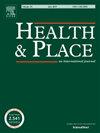Exploring the association between neighborhood disadvantage and cannabis retail density: A multi-measure analysis
IF 3.8
2区 医学
Q1 PUBLIC, ENVIRONMENTAL & OCCUPATIONAL HEALTH
引用次数: 0
Abstract
Introduction
There is growing interest in the relationship between neighborhood disadvantage and increased cannabis retail density, driven by evidence suggesting higher density is associated with increased cannabis use. Yet little is known on how this relationship varies across different measures of cannabis retail density. This study explores how measures of neighborhood advantage and disadvantage relate to four cannabis retail density measures in the US.
Methods
Data on licensed recreational cannabis retailers (n = 5586) were obtained from 18 state agency websites, geocoded, and spatially joined to 3369 census tracts to calculate four retail density measures: count per tract, cannabis retailers per 1000 population, per square mile, and per 10 miles of roadway. Multilevel regression models assessed the association between three Index of Concentration at the Extremes (ICE) measures—capturing tract concentration of racial and economic advantage/disadvantage—and the four cannabis retail density measures.
Results
Census tracts with the highest concentrations of economic and racialized/economic disadvantage exhibited greater odds of increased cannabis retail density across all measures, compared to tracts with the highest concentration of advantage. Tracts with the greatest concentration of racialized populations did not show a higher count or density per population but did exhibit higher density per square mile and per roadway.
Conclusion
On average, cannabis retail density is higher in neighborhoods with the greatest structural disadvantage. Researchers, public health agencies, and policymakers should use multiple measures of cannabis retailer density in surveillance and evaluation efforts to identify policy strategies that would most effectively reduce the clustering of cannabis retailers in areas primarily occupied by low-income or racialized populations.
邻域劣势与大麻零售密度的关系:一项多指标分析。
导言:有证据表明,高密度与大麻使用增加有关,因此人们对社区劣势与大麻零售密度增加之间的关系越来越感兴趣。然而,这种关系在不同的大麻零售密度测量中是如何变化的,我们知之甚少。本研究探讨了邻里优势和劣势的措施是如何与美国的四种大麻零售密度措施相关的。方法:从18个州机构网站获得有执照的休闲大麻零售商的数据(n = 5586),对其进行地理编码,并在空间上与3369个人口普查区相结合,以计算四种零售密度指标:每个区域的数量、每1000人口的大麻零售商数量、每平方英里的数量和每10英里的道路。多层回归模型评估了三种极端浓度指数(ICE)措施(捕捉种族和经济优势/劣势的区域浓度)与四种大麻零售密度措施之间的关联。结果:经济和种族/经济劣势最集中的人口普查区与优势最集中的地区相比,在所有措施中都表现出更大的大麻零售密度增加的可能性。种族化人口最集中的地区并没有显示出更高的人口数量或密度,但每平方英里和每条道路的密度确实更高。结论:大麻零售密度在结构劣势最大的街区平均较高。研究人员、公共卫生机构和政策制定者应在监测和评价工作中使用多种衡量大麻零售商密度的措施,以确定最有效地减少大麻零售商聚集在主要由低收入或种族化人口占据的地区的政策战略。
本文章由计算机程序翻译,如有差异,请以英文原文为准。
求助全文
约1分钟内获得全文
求助全文
来源期刊

Health & Place
PUBLIC, ENVIRONMENTAL & OCCUPATIONAL HEALTH-
CiteScore
7.70
自引率
6.20%
发文量
176
审稿时长
29 days
期刊介绍:
he journal is an interdisciplinary journal dedicated to the study of all aspects of health and health care in which place or location matters.
 求助内容:
求助内容: 应助结果提醒方式:
应助结果提醒方式:


